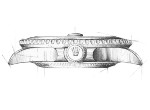
Being on some rep boards for more than 12 years my interest in the early days was mainly in chronographs from the well known brands as Omega, IWC and Tag. After a while I added Pam’s and an occasional stray like Chopard Mille Miglia Gran Turismo XL chrono with its distinctive rubber strap with vanilla scent, even after 12 years!! (fantastic watch, keeper), Anonimo (let go), Ebel Discovery 1911 chrono (first 1:1 rep imho, keeper) , Breitling B01 (let go) and a Baume & Mercier Riviera chrono (let go, regrets). So I thinned the herd as it was unrealistic and a waste of money to own over 50 reps next to a bunch of gens. Becoming more and more interested in Rolex/Tudor the last couple of months I tried to dive into the brands as much as I could to learn. One thing I got intregued by was the bezel click of this brand as my first 5513 had no clicks…..I was shocked and was ready to type an email to my TD but instead decided to get me some info….
Many people think that the Turnograph was the first Rolex made with a rotating bezel. It wasn't the very first, but it was the first serially produced Rolex with a rotating bezel. The very first was the rare Ref. 3346 from 1937. The Ref. 3346, also known as the Zerographe, is the rarest Rolex ever made. It was a prototype and only 7 to 12 are thought to have been made, with only 4 surfacing at auctions. It was the first (and only) Rolex to have a flyback chronograph and the second to have a California dial.
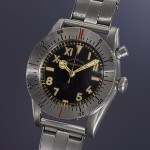
This was interesting because it had an outer black rotating bezel. This watch was not popular, however, it is historically important because it spawned both the Sub, and the GMT which became two of the best selling watches of all time for the Company.
Early bezels on the Turn-O Graph, the Sub, and the GMT were all bi-directional with no clicks. It was a friction ring that did the trick. You pushed down on the ring to "unlock" it, and then rotate it to where you wanted, then released it and it stayed in place until it was moved again.. Rolex included this handy reference for the user:

This was seen as a safety issue for divers who needed the timer to time decompression sets or submerge time, and underwater, you didn't want to make a mistake or have the bezel turned in the wrong direction so in the late 70's/80's we got the clicking version.
Since the clicking bezel started we now have:
. Any Sub, 120 clicks and counter-clockwise rotation only, aluminum insert (newest releases will be ceramic)
. Sea Dweller, 120 clicks and counter-clockwise rotation only, aluminum insert
. The New DSSD, 120 clicks and counterclockwise only, ceramic insert.
. The GMT II 16710, 120 clicks and rotates either direction, aluminum insert
. The GMT II 116710, 24 clicks and rotates in either direction, ceramic insert
. The Turn-O Graph, which was re-introduced in the 70's as a DateJust line, no-clicks and turns either direction, solid bezel. Discontinued in 2011.
. The Yachtmaster, 120 clicks, rotates in either direction, precious metal insert.
. The Yachtmaster II, partial-rotating bezel for function actuation, ceramic insert..
The rotatable bezel plays an essential role in diver safety by providing a reliable means of recording the time spent under water. A composite of technical know-how, the bezel is additionally a distinctive feature of this most emblematic of divers’ watches.
The importance of the Submariner’s bezel goes beyond its purely functional purpose. The distinctive bezel is not only indispensable for divers, to track immersion time and decompression stages, it has forged the identity of Rolex’s first and most emblematic divers’ watch. Visually, the rotatable bezel frames the dial and marks a natural boundary between the heart of the watch and the case. Thanks to its sophisticated construction, it turns smoothly, precisely and reliably. The various enhancements introduced since it was first launched reflect the constant innovation process implemented at Rolex.
Rolex produced the very first Submariner in 1953 with this model ref. 6204 watch. The Rolex Oyster Perpetual Submariner would go on to not only become one of the most iconic timepieces in the world, but also one of the most heavily emulated, desired, and studied. The Rolex Submariner was the first diver’s watch from Rolex and followed a legacy that started in 1926 when Rolex released its first water-resistant watch, the Oyster.

The Submariner is immediately recognizable thanks to its rotatable bezel. On the first version launched in 1953, the 60-minute graduated black insert was made of anodized aluminium, and the bezel turned with the help of a circular flat spring, which held it in the chosen position. The whole system operated independently of the heart of the case; in this way, the waterproofness of the case remained intact. The vertical fluting around the edge offered a good grip for turning the bezel.
This first version laid the foundations for a strong design, which would gradually evolve. The first evolution concerned the triangle, the starting point for all timing. For visibility in dark conditions, a dot of luminescent material was added, later replaced by a luminescent capsule. The bezel was graduated at five-minute intervals with numbers from 10 to 50 and intermediate markers; the triangle served as the 60-minute marker. From the very outset, a strong contrast was achieved by the grey-white colour of the natural aluminium graduations against the bezel’s black background.
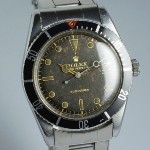
Modifications introduced in the late 1950s initially altered the bezel graduations. For more accurate timing of decompression stages, the first 15 minutes were marked off in individual minutes. The morphology of the bezel was also rethought, now with deeper cut, bevelled knurling. Rolex also introduced, as earlier mentioned, a “press and turn” locking system, so that the bezel needed to be pushed down before it could be turned. In 1979, this was replaced by a unidirectional serration, whose construction would again evolve. Today it is comprised of four vertical spring-mounted elements: a click that pushes up into toothing under the bezel to create a form of ratchet system and fulfil the anti-reverse function, and three small steel ball bearings, which supply the rotation torque.
One complete turn comprises 120 positions, or one per 30 seconds. This new construction results in an even more secure feel and enhanced fluidity when the bezel is turned. It has since been extended to all the brand’s divers’ watches.
Sophisticated design enhances fluidity when the rotatable bezel is turned and ensures precision and reliability.
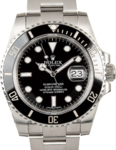
The ultimate refinements to the Submariner’s bezel affected the colours and the materials from which it is made. In 1969, the bezel made its first appearance in gold – like the watch – with clear graduations on a blue anodized aluminium insert. In 2003, to celebrate the model’s 50th anniversary, a steel version with a green bezel was launched. But the most recent, major evolution came in 2008 when the aluminium was superseded by the Cerachrom insert, an exclusive bezel component developed by Rolex. Manufactured from a particularly hard, corrosion-resistant ceramic, the Cerachrom bezel is virtually impervious to scratches and its colour is unaffected by the sun’s ultraviolet rays. It also offers excellent polishability ensuring an exceptional, long-lasting lustre.
Each disc is injection moulded, with inset numerals and graduations, and then coloured via a PVD (Physical Vapour Deposition) surface treatment that covers the whole of the insert with a thin layer of either gold or platinum. This layer of precious metal (approximately one micron thick) also coats the inset numerals and graduations. Polishing removes the gold or platinum from the rest of the bezel’s surface and achieves a smooth and lustrous finish. The metal in the numerals and graduations remains, making them clearly visible and extremely durable.
When the Submariner’s bezel is turned, the feel and the sound give the clear impression of an object designed and manufactured with the greatest care and attention. The rotatable bezel feels good in the hand. A masterpiece of fluidity and precision, it is also easy to grip. It rotates notch by notch, accompanied by characteristic crisp clicks that convey a sense of quality and reliable functioning. To ensure this unique experience for those who wear its watches, Rolex is equipped with a sensory analysis laboratory, which is entirely dedicated to maximizing the visual, tactile and acoustic perception of its products.
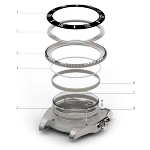
1/ Cerachrom bezel insert In virtually scratchproof ceramic, it is friction fitted into the rotatable bezel.
2/ Bezel insert ring Supports the Cerachrom insert inside the rotatable bezel.
3/ Rotatable bezel Equipped with toothing on the underside for the ratchet system and anti-reverse function (in interaction with the bezel click).
4/ Bezel fastening ring Slots into a groove in the bezel and holds it around the crystal by gripping the crystal securing ring.
5/ Bezel click The spring-mounted, bevelled click pushes up into the toothing under the bezel for the ratchet system and anti-reverse function.
6/ Crystal securing Ring in titanium Secures the synthetic crystal gasket tight onto the watch case.
7/ Sapphire crystal Virtually scratchproof, it is seated in a synthetic gasket.
8/ Synthetic crystal gasket Holds the sapphire crystal against the case and ensures a waterproof seal.
Please feel free to add any relevant info as I am still a newbee on Rolex.
Thanks for reading.....



